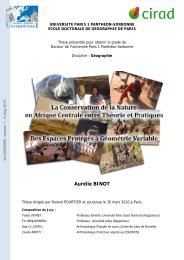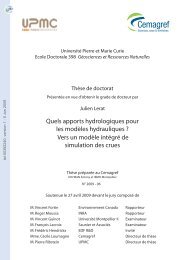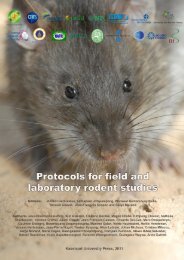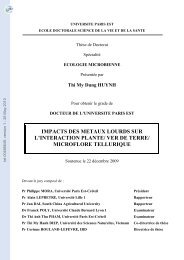Modeling and Inversion in Thermal Infrared Remote Sensing over ...
Modeling and Inversion in Thermal Infrared Remote Sensing over ...
Modeling and Inversion in Thermal Infrared Remote Sensing over ...
Create successful ePaper yourself
Turn your PDF publications into a flip-book with our unique Google optimized e-Paper software.
246 F. Jacob et al.ird-00392669, version 1 - 9 Jun 2009– Surface brightness temperature is equivalent to the radiance outgo<strong>in</strong>g from thetarget, by assum<strong>in</strong>g a unity emissivity [50], <strong>and</strong> corresponds to the basic TIRremote sens<strong>in</strong>g measurement. It is rec<strong>over</strong>ed from at sensor measurements perform<strong>in</strong>gatmospheric corrections. It can be assimilated, us<strong>in</strong>g model<strong>in</strong>g tools forl<strong>and</strong> surface, <strong>in</strong>to process models such as SVAT <strong>and</strong> crop models [18, 38, 39, 43].– Ensemble waveb<strong>and</strong> emissivity is needed to derive radiometric temperature frombrightness temperature [50, 51]. It is also useful for retriev<strong>in</strong>g ensemble broadb<strong>and</strong>emissivity, a key parameter for l<strong>and</strong> surface radiative budget [52–54].– Ensemble radiometric temperature is emissivity normalized [50, 51]; <strong>and</strong> correspondsto k<strong>in</strong>etic temperature for an homogeneous <strong>and</strong> isothermal surface [55].It is used to estimate surface energy fluxes <strong>and</strong> water status from spatial variability<strong>in</strong>dicators: the vegetation <strong>in</strong>dex / temperature triangle [41, 56–58]; or thealbedo / temperature diagram [23, 37, 59, 60]. It is also used for retriev<strong>in</strong>g soil<strong>and</strong> vegetation temperatures from two source energy balance model<strong>in</strong>g [19, 24].– Aerodynamic temperature is air temperature at the thermal roughness length [50].It is the physical temperature to be used with one source models of surface energyfluxes based on excess resistance [61–63]. These can be SVAT models [39, 64];or energy balance models [22, 23, 37, 59, 60, 65, 66].– Soil <strong>and</strong> vegetation temperatures correspond to k<strong>in</strong>etic [67] or radiometric [68]temperatures. They are often used for two-source model<strong>in</strong>g. The latter can beSVAT models [43, 67, 69]; or energy balance models [70, 20, 71]. Retriev<strong>in</strong>gthese temperatures requires an adequate estimation of directional ensemble emissivity.– Sunlit <strong>and</strong> shaded components are ref<strong>in</strong>ements of soil <strong>and</strong> vegetation temperatures.They can significantly differ, accord<strong>in</strong>g to various factors which drive thethermal regime: the water status, the solar exposure result<strong>in</strong>g from the canopygeometry <strong>and</strong> the illum<strong>in</strong>ation direction. These components are of <strong>in</strong>terest forunderst<strong>and</strong><strong>in</strong>g canopy directional brightness <strong>and</strong> radiometric temperatures [58,72–74].– Canopy temperature profile, from the soil surface to the top of canopy, is thef<strong>in</strong>est temperature one can consider. Similarly to sunlit <strong>and</strong> shaded componentsfor soil <strong>and</strong> vegetation temperatures, this thermal regime is considered for underst<strong>and</strong><strong>in</strong>gcanopy directional brightness <strong>and</strong> radiometric temperatures, <strong>in</strong> relationwith local energy balance with<strong>in</strong> the canopy [75–78].The seek accuracies vary from one application to another,accord<strong>in</strong>g to the sensitivitiesof process models. For temperature, the goal is accuracy better than 1 K [79].For emissivity, the goal is absolute accuracy better than 0.01 [80]. Rec<strong>over</strong><strong>in</strong>g bothrelies on exploit<strong>in</strong>g the dimensions of the TIR remotely sensed <strong>in</strong>formation.10.3 Available Information from TIR <strong>Remote</strong> Sens<strong>in</strong>gUncorrected ProofThe four dimensions of the remotely sensed <strong>in</strong>formation are temporal <strong>and</strong> spatial(Section 10.3.1), <strong>and</strong> spectral <strong>and</strong> directional (Section 10.3.2). Due to orbital rules
















